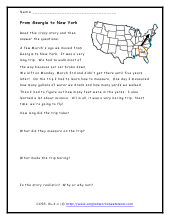Using Details and Examples Worksheets:
From Georgia to New York – Walking most of the way from Georgia to New York? People did it often many years ago.
All Hail The King! – An invitation from the king for you to the Dinner of Tigers.
A Trip to the Moon – Sebastien can obviously make some pretty cool stuff!
Bart's Broccoli – He is not a big fan of the green monster!
Camping in July – Jellystone National Park here we come!
Julie, Sam, and a Faint Meow – One hot and sunny day Julie and Sam were walking down the burning hot road when they heard a faint meow.
Marla's Vacation – Marla's parents were planning a great vacation for the summer but we're keeping most of it a surprise.
Tyler and Brett – Tyler and Brett were playing in the backyard with some friends when they decided they needed a drink.
Visit to the Planetarium – Calvin and his David are sky buffs!
Skunky Reputation – Skunks have a bad reputation of being stinky little devils, but Sally Skunk wanted to change that.
Letters to Teacher – The two letters above were written to the same teacher by different people. Answer the questions based on the letters.
Two Kids, Two Pups: Part 1 – At least once a week, Heather and Brian would stop by the pet shop on their way home from school.
Two Kids, Two Pups: Part 2 – Part two should only be completed after part one. The story has been included below if it is needed as a refresher.
Friends and Change – Stacy and Stephanie had been best friends since Kindergarten but this year, things seemed different.
Kelsey and the War with the Ball – Kelsey picks up the ball and throws it as hard as she can against the garage door.
Get FREE English Worksheets In Your Email

